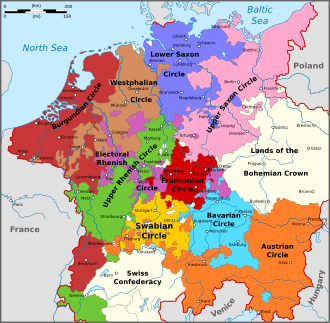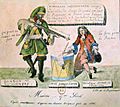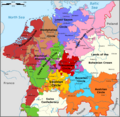Grand Alliance (League of Augsburg) facts for kids
| Grand Alliance between England, the United Provinces and Austria | |
|---|---|
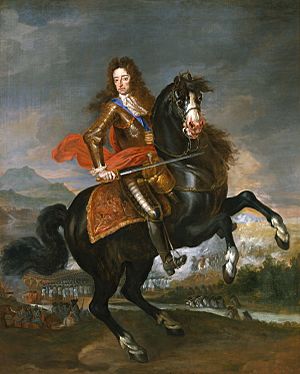
The architect of the Alliance, William III, Stadtholder of the Dutch Republic and King of England and Scotland
|
|
| Context | Anti-French Coalition |
| Signed | 20 December 1689 |
| Location | The Hague |
| Parties |
|
The Grand Alliance was a powerful group of countries that joined together against France. It was formed on December 20, 1689. The main members were the Dutch Republic, England, and the Holy Roman Empire (led by Austria).
The two most important leaders who signed the alliance were William III. He was the leader of the Dutch Republic and also the King of England. The other leader was Emperor Leopold I from Austria.
Later, Spain and Savoy also joined this group. The Grand Alliance fought against France in the Nine Years' War (1688–1697). This war ended with the Peace of Ryswick in 1697.
A Second Grand Alliance was formed later in 1701. This happened before the War of the Spanish Succession. This second alliance ended after the Peace of Utrecht in 1713.
Contents
Why the Grand Alliance Formed
The Grand Alliance was created because of the many wars started by Louis XIV, the King of France. These wars began in 1667 and lasted until 1714. France was growing stronger as Spain became weaker.
Louis XIV secretly supported the Ottomans against Austria. He also paid money to German states like Bavaria and Brandenburg-Prussia. This was to weaken Austria's power in the Holy Roman Empire.
In 1670, France took over the Duchy of Lorraine. Then, in 1683–1684, France took more land in Alsace. These actions threatened German states near the Rhineland.
In 1685, Louis XIV also stopped allowing French Protestants to practice their religion. About 200,000 to 400,000 Huguenots had to leave France. This made other Protestant countries, like the Dutch Republic and Brandenburg-Prussia, very worried. They saw Louis XIV as a danger to all Protestants in Europe.
How the Alliance Was Built
Emperor Leopold I of Austria was busy fighting the Ottomans. So, William of Orange helped create an anti-French group. This group was called the Union of Wetterau. It was made of German states in the Holy Roman Empire. Their goal was to "preserve the peace and liberties of Europe."
The Dutch Republic was not part of the Empire, so it wasn't in this Union. But many of the Union's leaders were Dutch officers. For the first time, members of the Union paid money for a central army. This made the army much stronger than if each state sent its own soldiers.
This new way of working together was used again in 1682. The Laxenburg Alliance was formed to protect the Rhineland. But it wasn't strong enough to stop France alone. In 1685, Louis XIV tried to claim half of the Electoral Palatinate. This caused another big problem.
After winning a battle against the Ottomans in 1683, Leopold could focus on France. In July 1686, the League of Augsburg was formed. This group combined the Laxenburg Alliance with other powerful regions.
On September 27, 1688, French forces attacked the Rhineland. This started the Nine Years' War. The anti-French group became even stronger in November 1688. This was when James II was removed from power in England. William of Orange then became King William III of England and Scotland.
The Dutch Republic declared war on France in March 1689. England followed in May.
Who Was in the Alliance?
The Grand Alliance included England, the Dutch Republic, Spain, and Austria. But there was also a wider anti-French group. This group included German states like Bavaria and the Palatinate.
Some kings were involved because they also ruled lands within the Holy Roman Empire. For example, Charles XI of Sweden was neutral as King of Sweden. But he was also a Duke in Swedish Pomerania, which was part of the League of Augsburg. The same was true for the Spanish Netherlands.
The Grand Alliance was important because it treated the Dutch Republic and England as equals to Emperor Leopold. This was a big deal in diplomacy at the time. When Savoy joined later, it was a major success for their leader, Victor Amadeus.
What the Alliance Agreed To
The Grand Alliance agreement was based on earlier deals between the Dutch Republic, Austria, and England. It was finally signed on December 20, 1689. There was a delay because Leopold was worried about accepting William as King of England. He also worried about English Catholics.
The main goals of the alliance were:
- To bring back the borders agreed upon in the Peace of Westphalia in 1648.
- To make the Duchy of Lorraine independent again.
- To make France accept that a Protestant would rule England next.
The countries also promised not to make a separate peace deal with France. If they did, it would help France too much, as happened in earlier wars.
There was also a secret part of the agreement. It said that England and the Dutch Republic would support Leopold's claim to the Spanish throne. This was important because Charles II of Spain had no children. This secret promise would later lead to another war.
What Happened After
The main fighting happened in the Spanish Netherlands. The Dutch did most of the fighting there. Austria's army was busy fighting the Ottomans in Eastern Europe. England and Scotland were busy with a war in Ireland until 1692.
When Spain and Savoy joined, new fighting areas opened up in Spain and Northern Italy. But these areas needed support from German soldiers paid for by the Alliance.
The Grand Alliance wanted to stop France from taking more land. The Nine Years' War was very expensive for everyone. Armies grew much larger, from 25,000 soldiers in 1648 to over 100,000 by 1697. This was too expensive for countries back then.
Between 1689 and 1696, England spent 80% of its government money on the military. One out of every seven adult men served in the army or navy. Other countries had similar problems.
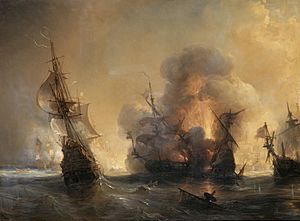
By 1693, both sides knew they couldn't win completely. France started talking about peace with the Dutch and Savoy. In August 1696, France and Savoy made a separate peace deal.
Wider peace talks were slow. Leopold wanted France to return all the land it had taken in the Rhineland since 1667. He also wanted an agreement on who would rule Spain next. He insisted his allies keep their promise not to make a separate peace.
The Peace of Ryswick was finally agreed upon. France returned Luxembourg to Spain. Louis XIV also recognized William as King of England. Despite this, Leopold signed the treaty with great hesitation in October 1697.
Leopold was right that not solving the Spanish succession problem would lead to another war. This happened in 1701 with the War of the Spanish Succession. But England and the Dutch felt Leopold's demands were making the expensive war last too long. It wasn't helping them much.
Studies show that English trade with Southern Europe dropped by over 25% between 1689 and 1693. Also, France captured over 90 merchant ships at Lagos in 1693. This caused huge financial losses in London and Amsterdam.
Because of this, many people in England, especially the Tories, did not want to spend money on European wars. They thought the money should be spent on the Royal Navy instead. This idea had a lasting impact on England's view of foreign wars.
See also
 In Spanish: Gran Alianza para niños
In Spanish: Gran Alianza para niños
Images for kids



